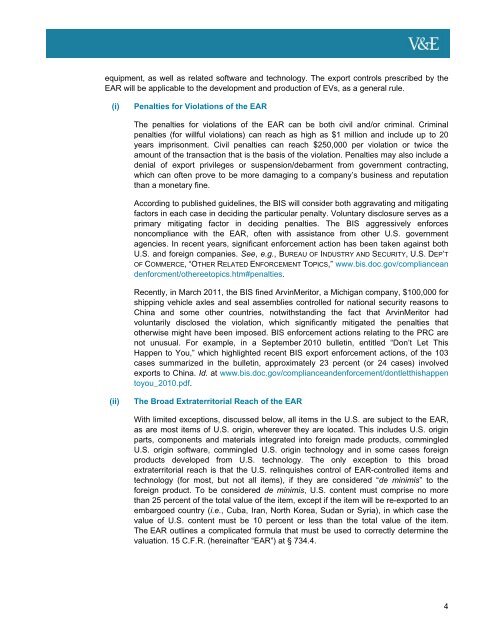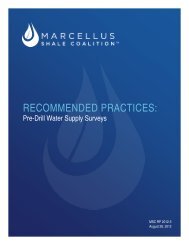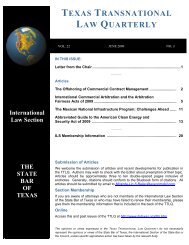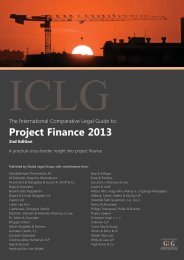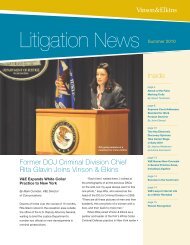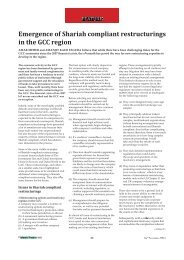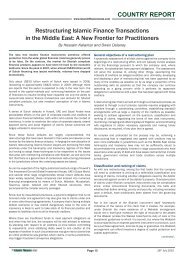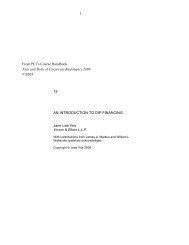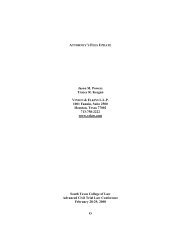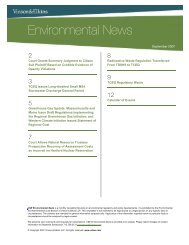Overview of U.S. Export Controls and Sanctions Issues Relating to ...
Overview of U.S. Export Controls and Sanctions Issues Relating to ...
Overview of U.S. Export Controls and Sanctions Issues Relating to ...
You also want an ePaper? Increase the reach of your titles
YUMPU automatically turns print PDFs into web optimized ePapers that Google loves.
equipment, as well as related s<strong>of</strong>tware <strong>and</strong> technology. The export controls prescribed by the<br />
EAR will be applicable <strong>to</strong> the development <strong>and</strong> production <strong>of</strong> EVs, as a general rule.<br />
(i)<br />
Penalties for Violations <strong>of</strong> the EAR<br />
The penalties for violations <strong>of</strong> the EAR can be both civil <strong>and</strong>/or criminal. Criminal<br />
penalties (for willful violations) can reach as high as $1 million <strong>and</strong> include up <strong>to</strong> 20<br />
years imprisonment. Civil penalties can reach $250,000 per violation or twice the<br />
amount <strong>of</strong> the transaction that is the basis <strong>of</strong> the violation. Penalties may also include a<br />
denial <strong>of</strong> export privileges or suspension/debarment from government contracting,<br />
which can <strong>of</strong>ten prove <strong>to</strong> be more damaging <strong>to</strong> a company’s business <strong>and</strong> reputation<br />
than a monetary fine.<br />
According <strong>to</strong> published guidelines, the BIS will consider both aggravating <strong>and</strong> mitigating<br />
fac<strong>to</strong>rs in each case in deciding the particular penalty. Voluntary disclosure serves as a<br />
primary mitigating fac<strong>to</strong>r in deciding penalties. The BIS aggressively enforces<br />
noncompliance with the EAR, <strong>of</strong>ten with assistance from other U.S. government<br />
agencies. In recent years, significant enforcement action has been taken against both<br />
U.S. <strong>and</strong> foreign companies. See, e.g., BUREAU OF INDUSTRY AND SECURITY, U.S. DEP’T<br />
OF COMMERCE, “OTHER RELATED ENFORCEMENT TOPICS,” www.bis.doc.gov/compliancean<br />
denforcment/otheree<strong>to</strong>pics.htm#penalties.<br />
Recently, in March 2011, the BIS fined ArvinMeri<strong>to</strong>r, a Michigan company, $100,000 for<br />
shipping vehicle axles <strong>and</strong> seal assemblies controlled for national security reasons <strong>to</strong><br />
China <strong>and</strong> some other countries, notwithst<strong>and</strong>ing the fact that ArvinMeri<strong>to</strong>r had<br />
voluntarily disclosed the violation, which significantly mitigated the penalties that<br />
otherwise might have been imposed. BIS enforcement actions relating <strong>to</strong> the PRC are<br />
not unusual. For example, in a September 2010 bulletin, entitled “Don’t Let This<br />
Happen <strong>to</strong> You,” which highlighted recent BIS export enforcement actions, <strong>of</strong> the 103<br />
cases summarized in the bulletin, approximately 23 percent (or 24 cases) involved<br />
exports <strong>to</strong> China. Id. at www.bis.doc.gov/compliance<strong>and</strong>enforcement/dontletthishappen<br />
<strong>to</strong>you_2010.pdf.<br />
(ii)<br />
The Broad Extraterri<strong>to</strong>rial Reach <strong>of</strong> the EAR<br />
With limited exceptions, discussed below, all items in the U.S. are subject <strong>to</strong> the EAR,<br />
as are most items <strong>of</strong> U.S. origin, wherever they are located. This includes U.S. origin<br />
parts, components <strong>and</strong> materials integrated in<strong>to</strong> foreign made products, commingled<br />
U.S. origin s<strong>of</strong>tware, commingled U.S. origin technology <strong>and</strong> in some cases foreign<br />
products developed from U.S. technology. The only exception <strong>to</strong> this broad<br />
extraterri<strong>to</strong>rial reach is that the U.S. relinquishes control <strong>of</strong> EAR-controlled items <strong>and</strong><br />
technology (for most, but not all items), if they are considered “de minimis” <strong>to</strong> the<br />
foreign product. To be considered de minimis, U.S. content must comprise no more<br />
than 25 percent <strong>of</strong> the <strong>to</strong>tal value <strong>of</strong> the item, except if the item will be re-exported <strong>to</strong> an<br />
embargoed country (i.e., Cuba, Iran, North Korea, Sudan or Syria), in which case the<br />
value <strong>of</strong> U.S. content must be 10 percent or less than the <strong>to</strong>tal value <strong>of</strong> the item.<br />
The EAR outlines a complicated formula that must be used <strong>to</strong> correctly determine the<br />
valuation. 15 C.F.R. (hereinafter “EAR”) at § 734.4.<br />
4


